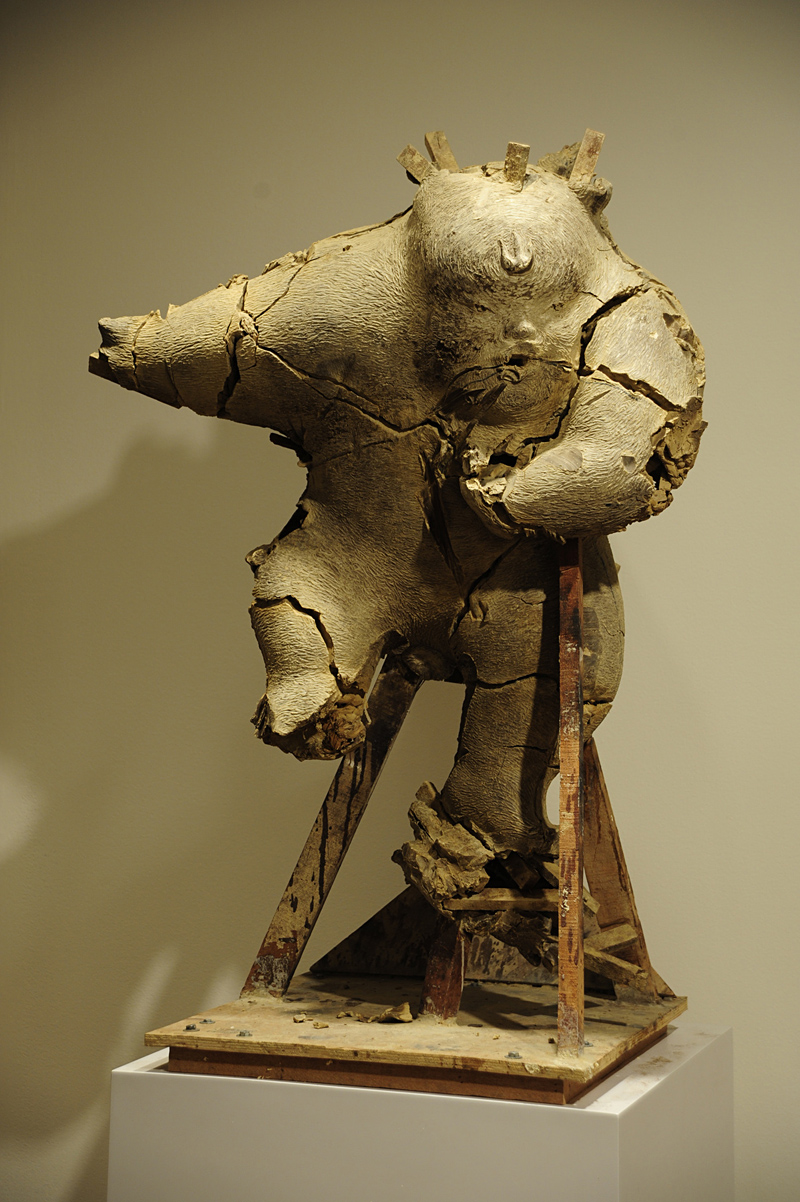Artists are usually poor advocates for their work, and the dreaded museum walk-through with an artist only compounds the problem. Add to that, among the odds stacked against Li Chen in his first U.S. museum show, the fact that his polite remarks were being translated from Mandarin as we critics trailed him through the Frye last month. He didn’t look comfortable being his own booster, but a smiling delegation of officials was eagerly videotaping his every word. It was a lot of worldly pressure on a quiet, unassuming guy whose work, he explained, expresses “the accumulation of time”—hardly compatible with a hasty sales spiel.
Born in Taiwan, Li seems to work in two distinct sculptural modes: the bright and shiny or the old and crumbly. In his Eternity and Commoner, we get to see the crumbly side of his work—pieces put together as if to decay, the clay cracked and moldering, cheap wooden lattices revealed within, pieces held together with old bits of wire and rope. The pudgy, cherub-faced outlines from his work have their basis in Buddhist temple figures, but here those faces have mostly rotted away (along with hands and feet). Four figures from his 2008 Soul Guardians series are highly distressed; they look like something from an archaeological dig. The pieces reflect what he termed “the natural cracking of the Earth . . . the penetrative forces of wind.” You could call that process erosion, only the ragged quartet has been carefully maintained and kept moist to preserve the appearance of decay.
There’s almost an aspect of assault, of violence, to these guardians—as if the elements are physically attacking them, reducing them back to dirt, as it were. Their individual titles suggest as much: Sky Breaking Gale, Earth Piercing Fire, Visual Perception, and Audio Perception. There’s the suggestion that light waves and audio waves, how we see and hear, are destructive processes. Or, in a more Buddhist view: a transformative process, part of the life cycle. “Whatever you see now may not be the same through the passage of time,” said Li. “Whatever we hear, whether true or false, will change over time.”
Lost in translation may be a political subtext— empires crumble, leaders change, history is rewritten—that comes through more obviously in the large new Eternity tableau, which is something like a giant chess set. Occupying its own gallery, the clay-and-wood installation has at its center a 12-root ruling figure clutching diamonds (or some sparkly surrogate) in his arms. He, clearly, is the leader—perhaps the emperor of some forgotten or fictive dynasty who, again, looks like he was dug out of the ground. And his ceremonial retinue also looks the worse for wear. These minions and guardians (plus even a dog?) are arrayed around him in “parade formation,” per Li, but the whole shabby group is something of a sham. This imperial power, though newly created expressly for the Frye, is already part of history. The formation is meant to impress on one level, but Li renders it obsolete.
Nearby, resting in a glass case, is still another figure seemingly unearthed. The humble wooden skeleton of Commoner is intended to contrast with the crumbled grandeur of Eternity. For every single emperor, we know, there are millions of anonymous peasants. This one, representing the many, clutches a bit of wheat—another token of growth and decay, of the historical seasons that sweep away one dynasty and bring new leaders to power. (Peasants, by implication, simply endure like grass trampled underfoot.)
Li’s work is conspicuously oriented to the past. And since he maintains a studio in Shanghai, too, any political reading of his work is clearly canted to the pre-Communist era. All regimes are subject to the grinding degradation of time, but it’s best not to address anything following 1949. Though his four battered guardians may appear ancient, we know that their wounds are fresh.









